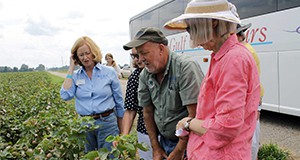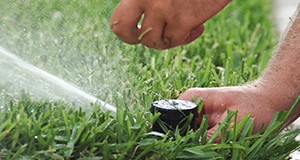
The Savvy Survey #7: Formatting Questionnaires is the seventh of seventeen Savvy Survey Series publications from state specialists with expertise in tailored design survey methodology. Developing a high-quality questionnaire is critical for collecting useful data. After selecting the best questions, the next step is to format them to produce the most effective questionnaire possible. This 7-page publication spotlights several considerations, including question order, layout for best visual appearance, and pagination. Written by Jessica L. Gouldthorpe and Glenn D. Israel, and published by the Agricultural Education and Communication Department.
https://edis.ifas.ufl.edu/pd071
Category: Program Development
Writing and Designing for the Web series
Knowing how to create and design a website is a valuable skill. This four-part series explains general tenants of good web design, covers the terminology and techniques involved in creating appealing, user-friendly websites, and also discusses basic HTML coding and developing visual elements for the web. Written by Ricky Telg, Laura Gorham, and Tracy Irani, and published by the UF Department of Agricultural Education and Communication, August 2015.
http://edis.ifas.ufl.edu/topic_series_writing_and_designing_for_the_web
Transparency in Agriculture and Natural Resources: Defining Transparent Communication
When we think about transparency, we usually think about business, public relations, and government; however; transparency is also an important consideration in agriculture and food industries. Defined as openness and the opposite of secrecy, transparency can be conceptualized as a communication strategy that the agricultural industry can use to interact with consumers and other audiences. This 3-page fact sheet defines transparent communication as containing substantial information, incorporating audience participation, and maintaining accountability. Written by Joy N. Rumble, and published by the UF Department of Agricultural Education and Communication, September 2015.
http://edis.ifas.ufl.edu/wc225
Priority Competencies Needed by UF/IFAS Extension County Faculty

Research shows that competency is a better indicator of employee potential than intelligence alone. This 5-page fact sheet outlines ten competency areas relevant to Extension county faculty, as well as examples of how Extension faculty might embody these qualities in their work. Written by Amy Harder, and published by the UF Department of Agricultural Education and Communication, September 2015.
http://edis.ifas.ufl.edu/wc236
Teaching to Personality Types series

A person’s personality affects the way he or she learns best. Extension programs can use an understanding of different learning styles and preferences to reach the greatest number of people. This 4-part series covers the various personality types and explains how Extension can teach to these types. Written by Alexa J. Lamm and Ricky W. Telg, and published by the UF Department of Agricultural Education and Communication, September 2015. (Photo credit: Rawpixel Ltd/iStock/Thinkstock.com)
http://edis.ifas.ufl.edu/topic_series_teaching_to_personality_types
Get SMART: Improve Your Extension Objectives

SMART Objectives assist educators and program planners in developing strong objectives that are Specific, Measurable, Achievable, Relevant and Time-bound. This 3-page fact sheet was written by David C. Diehl and Sebastian Galindo-Gonzalez. Published by the UF Department of Family Youth and Community Sciences, June 2012 and revised September 2015.
http://edis.ifas.ufl.edu/fy1327
Strategies to Encourage Adoption of Stormwater Pond Best Management Practices (BMPs) by Homeowners
Man-made ponds can be a useful way to collect, store, and treat stormwater runoff in residential areas. However, these ponds can become polluted when runoff contains fertilizers, pesticides, and pet waste from the neighborhood. This 8-page fact sheet outlines several best management practices (BMPs) for reducing stormwater pond pollution. Based on a survey of residents who live near stormwater ponds, the authors recommend strategies Extension educators can use to encourage residents to adopt these BMPs. Written by Emily Ott, Paul Monaghan, Ondine Wells, Gail Hansen, Laura Warner, and Michelle Atkinson, and published by the UF Department of Agricultural Education and Communication, July 2015.
http://edis.ifas.ufl.edu/wc214
Getting the Most out of Social Media

Agriculturalists can use social media as a powerful tool for marketing their products and establishing a brand identity. The goal of this series is to help agriculturalists understand how social media can work for them. The series also discusses the various social media platforms and how to use social media strategically and wisely. Written by Jessica C. Fernandez and Joy N. Rumble, and published by the UF Department of Agricultural Education and Communication, August 2015. (Photo credit: tanuha2001/iStock/Thinkstock.com)
http://edis.ifas.ufl.edu/topic_series_getting_the_most_out_of_social_media
Letting Them In: Sharing Your Story with People outside of Your Industry

Those who work in agriculture often face the challenge of explaining their work to people outside of their field. Identifying what your audience cares about is the first step in formulating a story you audience will understand and value. This 3-page fact sheet also offers do’s and don’ts for crafting a story for non-expert audiences. Written by Brandon Telg, Jaron Jones, and Ricky Telg, and published by the UF Department of Agricultural Education and Communication, July 2015. (Photo credit: monkeybusinessimages/iStock/Thinkstock.com)
http://edis.ifas.ufl.edu/wc216
Story Development
Stories let you share who you are with the world. Storytelling can help develop an organization’s identity, improve interactions with the public, and foster teamwork. This 2-page fact sheet covers the basics of good storytelling and strategies for crafting an engaging story. Written by Brandon Telg, Jaron Jones, and Ricky Telg, and published by the UF Department of Agricultural Education and Communication, July 2015. (Photo credit: elwynn1130/iStock/Thinkstock.com)
http://edis.ifas.ufl.edu/wc215
A Manual for the Design and Implementation of Teaching and Demonstration Gardens

Teaching and demonstration gardens are places where the public can learn about different types of gardens and landscapes. This 10-page fact sheet discusses the various types of gardens, how to plan and develop a demonstration garden, logistical and design considerations, and educational programming. Written by Gail Hansen, and published by the UF Environmental Horticulture Department, July 2015.
http://edis.ifas.ufl.edu/ep524
Storytelling through Social Media
You and organization can use social media to tell you story and reach a large and diverse audience. This 3-page factsheet covers the major social media platforms, what each platform offers, and how to use theme effectively. Written by Brandon Telg, Jaron Jones, Ricky Telg, and Becky Raulerson, and published by the UF Department of Agricultural Education and Communication Department, July 2015.
http://edis.ifas.ufl.edu/wc218
Face-to-Face Storytelling
In the agricultural industry, telling your story is critical for establishing your operation’s identity. Communicating face-to-face is one method of getting your message to the public. This 2-page fact sheet presents tips and strategies for delivering your story to a live audience. Written by Brandon Telg, Jaron Jones, and Ricky Telg, and published by the UF Department of Agricultural Education and Communication, July 2015.
http://edis.ifas.ufl.edu/wc217
Planning for a Farm Tour: Keeping the Conversation Fresh
Hosting tours at your farm can be a great way to market your products and your farm’s brand. Tours let you tell potential customers how you grow your food, why they should buy it, and who you are as a farmer. This 3-page fact sheet discusses these topics and provides logistical advice for planning and executing a successful farm tour. Written by Claire Mitchell and Joy N. Rumble, and published by the UF Department of Agricultural Education and Communication, August 2015.
http://edis.ifas.ufl.edu/wc219
Eight Steps to Developing a Simple Marketing Plan

Marketing is an essential component of any business, including agriculture. Despite the important role of marketing, many smallholding operators/growers are reluctant to create a marketing plan. This 5-page fact sheet provides a rationale for developing a marketing plan, a step-by-step process for creating one, and a marketing plan worksheet. Written by Edward A. Evans and Fredy H. Ballen, and published by the UF Department of Food and Resource Economics, August 2015. (Photo credit: iStock/Thinkstock)
http://edis.ifas.ufl.edu/fe967
Encouraging Landscape Water-Conservation Behaviors #3: Developing Extension and Outreach Messages That Encourage Landscape Water Conservation Practice Adoption
Message framing can be an effective tool for crafting messages for a target audience. This 5-page fact sheet explains how Extension can use gain and loss message framing to encourage Florida residents who irrigate their home landscape to adopt water-conservation practices. Part three of the series Encouraging Landscape Water-Conservation Behaviors and written by Courtney Owens, Laura Warner, Joy Rumble, Alexa Lamm, and Randall Cantrell, and published by the UF Department of Agricultural Education and Communication, June 2015.
http://edis.ifas.ufl.edu/wc201
Using the Decision-Ade(TM) Segmentation Strategy to Better Understand Extension Audiences

Decision-Ade™ is a tool Extension can use to better understand how residents with a range of household budgets feel about their utility bills. Analyzing households in terms of both income and utility bill “botheredness” creates a more comprehensive picture of that household’s utility use and its willingness to modify utility consumption relative to other households. This 5-page fact sheet uses survey data of Florida residents to demonstrate the insights Decision Ade™ can provide and how those insights can inform Extension programming. Written by Randall Cantrell, Laura Warner, Joy Rumble, and Alexa Lamm, and published by the UF Department of Family, Youth and Community Sciences, July 2015.
http://edis.ifas.ufl.edu/fy1461
Positive Discipline: Behavioral Management Skills for Parents and Teachers, Part 3: Fostering the Parent-Child and Teacher-Student Relationship to Build Responsibility
Tell me and I forget,
Teach me and I may remember,
Involve me and I learn.
The general goal of healthy parenting and teaching is to produce children and students who can think critically, make good decisions, and become independent, accountable, responsible, and contributing members of society. Part 3 of this Positive Discipline: Behavioral Management Skills for Parents and Teachers series covers tips and strategies to help parents and teachers build critical thinking and positive behavioral skills in children. Several of these strategies that can help parents and teachers achieve these goals through “love and logic” are discussed in this 6-page fact sheet written by Victor Harris, Whitney Fung, Sarah Ellis, and Alison Schmeer, and published by the UF Department of Family Youth and Community Sciences, July 2015. (Photo Credit: Thinkstock.com/iStock/natasaadzic)
http://edis.ifas.ufl.edu/fy1460
Positive Discipline: Behavioral Management Skills for Parents and Teachers, Part 2: General Approaches to Managing Behavior
When a child is locked in the bathroom
With water running
And he says he is doing nothing
But the dog is barking,
Call 911.
–Erma Bombeck
Research indicates that there must be at least an 8-to-1 positive-to-negative interaction ratio for parents and teachers to have a positive relationship with their children and students. Put simply, both verbal and non-verbal communication needs to be generally positive. Learning how to steer a child or a student toward managing his or her own behavior in healthy ways requires both knowledge and skills that make it easy to have positive interactions and behavior change. This 6-page fact sheet will help you identify specific approaches to successfully managing appropriate and inappropriate behavior at home and in the classroom. It outlines four principles of behavior management, and describes several strategies before providing a practice activity. Written by Victor Harris, Whitney Fung, Sarah Ellis, and Alison Schmeer, and published by the UF Department of Family Youth and Community Sciences, July 2015. (Photo Credit: Thinkstock.com/Jupiterimages/Creatas Images)
http://edis.ifas.ufl.edu/fy1459
Positive Discipline: Behavioral Management Skills for Parents and Teachers, Part 1: Types of Misbehaviors and Keys to Success
“Before I got married I had six theories about bringing up children; now I have six children, and no theories.” — John Wilmot
Parents and teachers often experience a lot of insecurities, especially with regard to helping children manage their own behaviors. Not surprisingly, there are many similarities in the skills that effective parents and teachers use to help children manage their own behavior successfully. Building a foundation for healthy and effective parenting and teaching begins with understanding some different types of misbehaviors. This 4-page fact sheet discusses four common types of misbehaviors, encourages the reader to identify healthy and unhealthy practices, and continues with key factors of effective parenting and teaching. Written by Victor Harris, Whitney Fung, Sarah Ellis, and Alison Schmeer, and published by the UF Department of Family Youth and Community Sciences, July 2015. (Photo credit: Thinkstock.com/iStock)
http://edis.ifas.ufl.edu/fy1458









